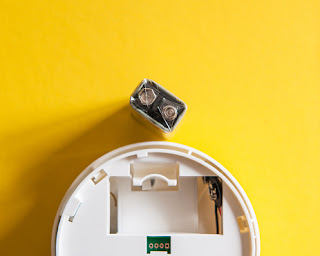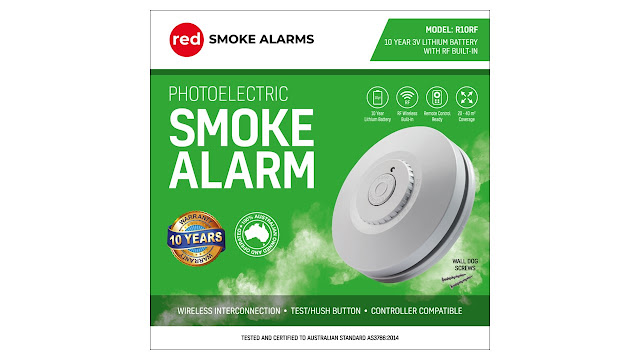Your Smoke Alarm Battery - Essential Care Tips
Photoelectric smoke alarms are a vital safety feature in any
home or building. They work by detecting smoke particles in the air and
sounding an alarm to alert occupants of a potential fire. However, like any
other lifesaving electronic device, photoelectric smoke alarms require
batteries to operate effectively. In this blog post, we will discuss the
importance of your smoke alarm battery and offer tips on how to maintain it.
Why is
your smoke alarm battery important?
The batteries in a photoelectric smoke alarm are essential
because they provide the power necessary to detect smoke particles in the air. Quite
obviously, without functioning batteries the photoelectric smoke alarm would cease
to operate – it would not be able to detect smoke and would not sound the
alarm, leaving occupants at risk in the event of a fire. When a smoke alarm
battery becomes low on power it may make the smoke alarm more susceptible to
false / nuisance alarms. Even in situations where you have a 240v hard wired
smoke alarm, the hard wired smoke alarm will contain a battery to supply
temporary back-up power if there is a loss of the 240v mains household power.
Additionally, photoelectric smoke detectors are often
installed in hard-to-reach places such as ceilings, making it difficult to
check the batteries regularly. Therefore, it is beneficial to choose
high-quality batteries that will last longer and require less frequent
replacement.
How to
maintain a smoke alarm battery
Here are some tips on how to maintain photoelectric smoke
alarm batteries to ensure they are always functioning properly:
Check the batteries regularly: It is important to
check the batteries in your photoelectric smoke alarms regularly to ensure they
are functioning properly. A good rule of thumb is to check the batteries every
six months and replace them as necessary. As per Australian Standard 3786:2014
the photoelectric smoke alarm must also have a low battery warning, which will
alert you when it's time to replace the smoke alarm battery (otherwise known as
the annoying ‘chirp’).
Use high-quality batteries: It is important to use
high-quality batteries in your photoelectric smoke alarms to ensure they last
longer and require less frequent replacement. The old adage rings true
–‘cheapest is not always the best’ and you get what you pay for. Lithium
batteries are a good choice because they have a longer life span and are less
likely to leak than alkaline batteries.
Keep spare batteries on hand: It's always a good idea
to keep spare batteries on hand in case of an emergency. If you don't have
spare batteries and the batteries in your photoelectric smoke alarm die, you
will be left without a functioning alarm until you can replace them.
Test the alarm regularly: It's important to test your
photoelectric smoke alarm regularly to ensure it is functioning properly. Your
smoke alarm will have a test button that you can press to sound the alarm and
make sure it's working. Most modern reputable smoke alarm brands such as Red
smoke alarms will also have an optional remote control device to test the smoke
alarm.
Replace the entire unit every 10 years: Photoelectric
smoke alarms should be replaced 10 years from manufacture date to ensure they
are functioning properly. Even if the batteries are still good, the sensors in
the alarm can degrade over time, reducing its effectiveness.
The smoke
alarm lithium battery
To make smoke alarm battery maintenance even easier, most
modern photoelectric smoke alarms come with a 10-year lithium battery which is
sealed inside the smoke alarm itself. The battery is non replaceable and lasts
for the entire lifetime of the alarm. After 10 years, the entire unit (both the
smoke alarm and the smoke alarm battery) is disposed of and replaced with a new
one. When there is a non-replaceable smoke alarm battery, section 4.22.1(i) of
Australian Standard 3786:2014 states that the following message must be printed
on the rear of the smoke alarm ‘WARNING: BATTERY NOT REPLACEABLE – SEE
INSTRUCTION MANUAL’.
Hard
wired smoke alarm with back-up smoke alarm battery
Red smoke alarms are a brand which manufacture two slightly
different models of hard wired smoke alarm. As the name suggests, the smoke
alarm is hardwired into 240v household mains power. The variation between each
model is due to the difference in the back-up smoke alarm battery. The back-up
battery in the Red smoke alarm R240 model is a 9volt replaceable battery which
must be replaced annually. The smoke alarm battery in the Red smoke alarm R240RCmodel is a rechargeable lithium battery – this means the battery never needs to
be replaced for the life of the alarm.
In conclusion, photoelectric smoke alarms are an essential
safety feature in any home or building. It is important to maintain the smoke
alarm battery to ensure the fire alarms are functioning properly and can detect
smoke in the air. By checking the batteries regularly, using high-quality
batteries, keeping spare batteries on hand, testing the alarm regularly, and
replacing the entire unit every 10 years, you can ensure that your
photoelectric smoke alarms are always functioning properly. Modern smoke alarms
contain a non-replaceable lithium battery which is sealed inside the unit and
never needs replacing for the life of the alarm (10 years). Even a hard wired
smoke alarm will contain a back-up battery to supply power in the event of a
loss of 240v mains household power. The smoke alarm battery is an essential
component within any smoke alarm. By following the tips in this article, you
will ensure your safety, and that of your family is never compromised.
For all your smoke alarm battery needs, please check us out today at www.photoelectricsmokealarms.com.au



Comments
Post a Comment